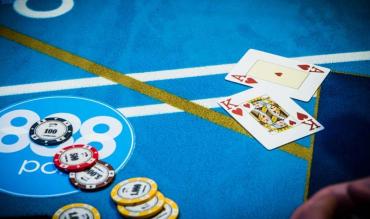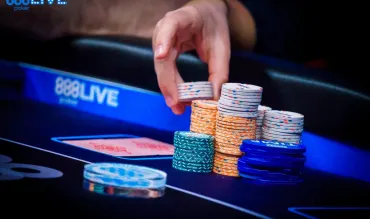There is a huge variety of poker advice out there. Every poker player, coach, and training site has an opinion. The problem is that these opinions are often very different from each other.
Even widespread poker beliefs may turn out to be inaccurate when we look more closely.
This 888poker article is dedicated to the top 5 preflop myths in poker.
Myth No. 1 – Never Cold Call in the Small Blind
The Myth
Many players believe that they should never call in the small blind when facing an open raise.
They may mention reasons like the following:
- It’s bad strategy because the big blind may squeeze.
- They have GTO (game theory optimization) preflop ranges that show no cold calling in the small blind.
It's easy to see why a player might assume it is bad to cold call out of the SB, especially if their GTO ranges have no SB cold calling.
The Truth
It’s important to consider why a set of solved preflop ranges has no cold calling range out of the small blind.
In most cases, it’s because the ranges used a game tree that didn’t have an option to cold call out of the small blind. This is commonly done to reduce computer memory requirements (RAM) for running a preflop solve.
To put it simply, the solver is not avoiding SB cold calls for any GTO-based reason. It’s avoiding SB cold calls because it was never given the option to cold call.

In recent times, more advanced solvers often include an SB cold call option. Given the option, the solver nearly always chooses to use some hands as SB cold calls.
Strategy Advice
Many winning players choose to have no cold call range in the SB. This may still be a reasonable strategy choice (based on the idea that it “simplifies” gameplay), but it’s certainly not a GTO-correct approach.
In many spots a poker solver does not have an especially wide SB cold calling range anyway. Playing 3bet only from in these scenarios may not affect our win rate too much.
However, when playing against small opens (especially min raises) and late position opens (especially from the button), a GTO solver cold calls often out of the SB. Playing three-bet only from such positions might easily not be the best approach.
Myth No. 2 – Three-betting Aggressively Reduces the Amount of Rake Paid
The Myth
In the online world, it’s the smallest stakes (micro stakes) games that are known for charging the most rake. Although rake is necessary to make the games viable for the poker room, players would prefer to pay as little rake as possible.
The idea was invented that by three-betting aggressively poker players could end up paying less rake. The logic revolves around the idea that no rake is taken for pots that end preflop. By forcing more pots to end on the preflop betting round, we could be charged less rake overall.
This idea was popularized by various high-profile poker players and poker training sites. The question is, does the idea hold any weight?
The Truth
This widely-spread idea falls apart quickly even when subject to some basic forms of analysis.
Analysis method 1 – basic math
Let’s use a simplified example and assume that a poker room takes 5% rake on all pots that reach the flop. (We call it simplified because we are going to ignore any possible rake cap).
Let’s also define a few rough numbers:
- Average villain fold to three-bet frequency – 50%
- Average size of the pot after hero cold calls – 5.5bb
- Average size of the pot when hero’s three-bet gets called – 20bb
When we three-bet preflop, we play a 20bb pot 50% of the time. This is equivalent to playing a 10bb pot 100% of the time.
If we instead cold call we will play a 5.5bb pot 100% of the time.
Which is larger? 5% of a 5.5bb pot? Or 5% of a 10bb pot? Hopefully the answer is obvious – Three-betting pays more rake, even if villain sometimes folds.
Analysis method 2 – empirical analysis
Some players are still sceptical even when looking at the math.
However, the conclusion is easily confirmed through poker tracking software. Players who three-bet aggressively preflop pay a lot more rake than players who mostly cold call.
Given that the conclusions are very straightforward, we are left with an obvious question. How exactly do advanced players continue to believe the myth that three-betting aggressively reduces the amount of rake paid?
Strategy Advice
The desire to pay less rake is not a valid reason to cut out 3bets from our game. We should three-bet aggressively preflop despite paying more rake for the privilege.
This is because although we pay more rake, the expected value of three-betting aggressively is still higher overall.

Solver output also confirms that it is correct to three-bet more aggressively in high-rake environments compared to low-rake environments.
In other words, three-betting more aggressively in high rake environments is correct, but the reason often given to justify the approach is a myth (three-betting aggressively doesn’t decrease rake paid).
The correct justification for three-betting aggressively is simply that it increases our overall win rate in high rake environments.
Myth No. 3 – Huge 3bets From the Blinds Generate More EV (Expected Value)
The Myth
As a result of solver output, many now players believe that it is correct to make huge three-bets out of the blinds.
In online environments, it’s common to see a button open of 2.5bb face a three-bet of 12 or 13bbs.
This is a result of multiple preflop solvers being run, each with a different available (but single) three-bet sizing.
The solver models with the larger three-bet sizings generate a higher EV on the three-bet. It was then assumed by many players that the large three-bet sizing must always be best.
The Truth
The analysis described above is incomplete since each individual model only makes use of a single three-bet sizing.
In more recent times, computers with larger amounts of resources have been used to run solvers where multiple three-bet sizings are available on a single model.
In such cases we see that the solver makes use of a range of different three-bet sizings (including smaller sizings). The short explanation here is that an overly large three-bet sizing doesn’t increase our theoretical EV.
Strategy Advice
The picture is not fully complete since we have only considered the EV of theoretical (GTO) play.
Assuming we are playing against a less-skilled opponent, it’s usually in our interest to keep extra chips available for postflop play (by using smaller preflop sizings). When there are more chips to play for postflop it allows us to capitalize on our postflop skill edge.
A poker solver always assumes that villain is a perfect opponent of equal skill and therefore doesn’t accurately mirror the real world.
If anything, weak opposition is an argument for making use of smaller three-bet sizings unless we have a premium holding.
It’s also clear (even on a GTO level) that we don’t need to always make use of the same three-bet sizing.
Myth No. 4 – It’s Incorrect to Complete in the SB (Small Blind)
The Myth
Even from the earlier days of online poker, good players had already figured out that open limping was unlikely to be the most profitable approach.
It was assumed (and still is by many players today) that this logic extends to the SB. If the action is folded around to us in the SB preflop, many players believe that we should either open raise or fold.
Open limping in the SB is referred to as “completing.” It’s different from limping since we have already made the mandatory 0.5bb SB post.
The Truth
Even before the wide availability of solvers, online players in the high stakes circle had begun to theorize that we should likely have a SB completing range. The main reason was simply that the price is very good on a SB complete. We are investing 0.5bb to potentially see a 2bb postflop pot.
In more modern times, solvers have confirmed that it is theoretically correct to have a completing range in the SB. The exact completing frequency will depend on the game tree, but solver completes in the SB with around 10% frequency.
Strategy Advice
Just because a solver only completes around 10% of the time does not necessarily mean this is the most profitable SB completing frequency.
Analysis of online poker players reveals that the average BB (big blind) is making sizable mistakes when facing a SB complete.
For example, theory suggests that BB should be raising around 40% of the time when facing a SB complete. The average BB is instead raising less than 30% of the time.
When we complete in the SB, we see a cheap flop way more frequently than we are supposed to. This increases the EV of our SB complete and increases the range of hands we can complete with profitably.
Myth No. 5 – Preflop Defending Ranges Can be Determined Using Pot Odds
The Myth
This is another myth that has been unknowingly propagated by high stakes professionals and training sites. It's a misunderstanding that revolves around basic poker math.
The myth is that we can determine the profitability of a preflop defend by simply considering our preflop pot odds.
The Truth
We can only use pot odds to determine the expected value of preflop situations that are all in. In other situations where there are still chips left to play for postflop, pot odds cannot give us a definitive answer.
This particular myth is so widespread that it has its own article here.
Strategy Advice
In the modern world, we don’t need to try and figure out preflop ranges by hand. Sets of solved preflop ranges are fairly common online and make an excellent starting point for fine-tuning our preflop game.
Check out this article for advice on finding spots where we can make the laydown preflop.
Watch Out for Other Poker Myths
If there is one takeaway here, it’s to take every piece of poker advice with a pinch of salt.
Even “basic” poker advice that everyone “knows,” or advice from big high stakes crushers can turn out to be based on myths.
We should always try to run our own independent research and reach our own conclusions on which information is trustworthy.


